1994 CHEVROLET CORVETTE engine oil
[x] Cancel search: engine oilPage 178 of 274
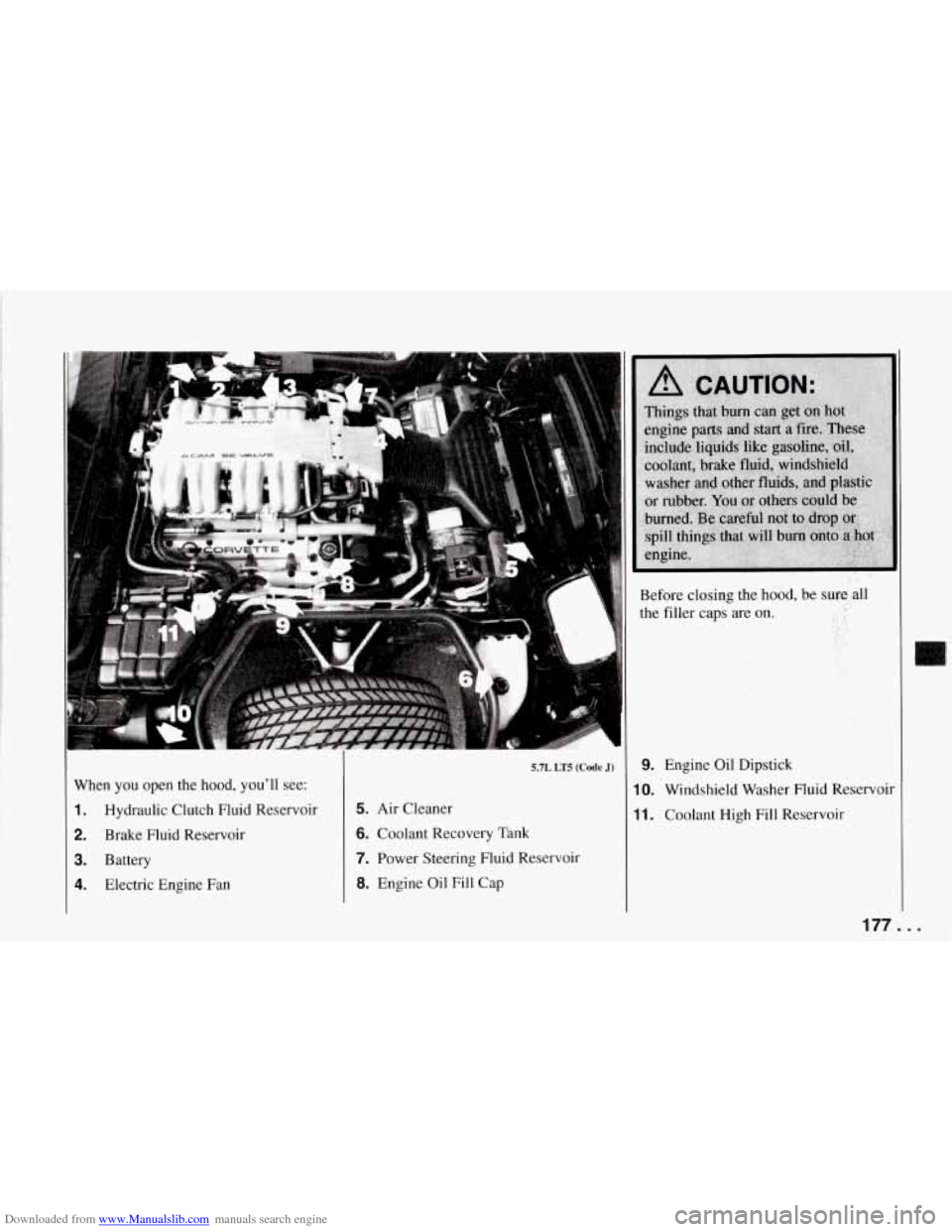
Downloaded from www.Manualslib.com manuals search engine r
k
"1
5.7L LT5 (Code J)
When you open the hood, you'll see:
1. Hydraulic Clutch Fluid Reservoir 5. Air Cleaner
2. Brake Fluid Reservoir 6. Coolant Recovery Tank
3. Battery 7. Power Steering Fluid Reservoir
4. Electric Engine Fan 8. Engine Oil Fill Cap Before closing
the hood, be
sureall
the filler caps are on. . ..
'., , ,.
9. Engine Oil Dipstick
10. Windshield Washer Fluid Reservoir
11. Coolant High Fill Reservoir
177..
Page 179 of 274
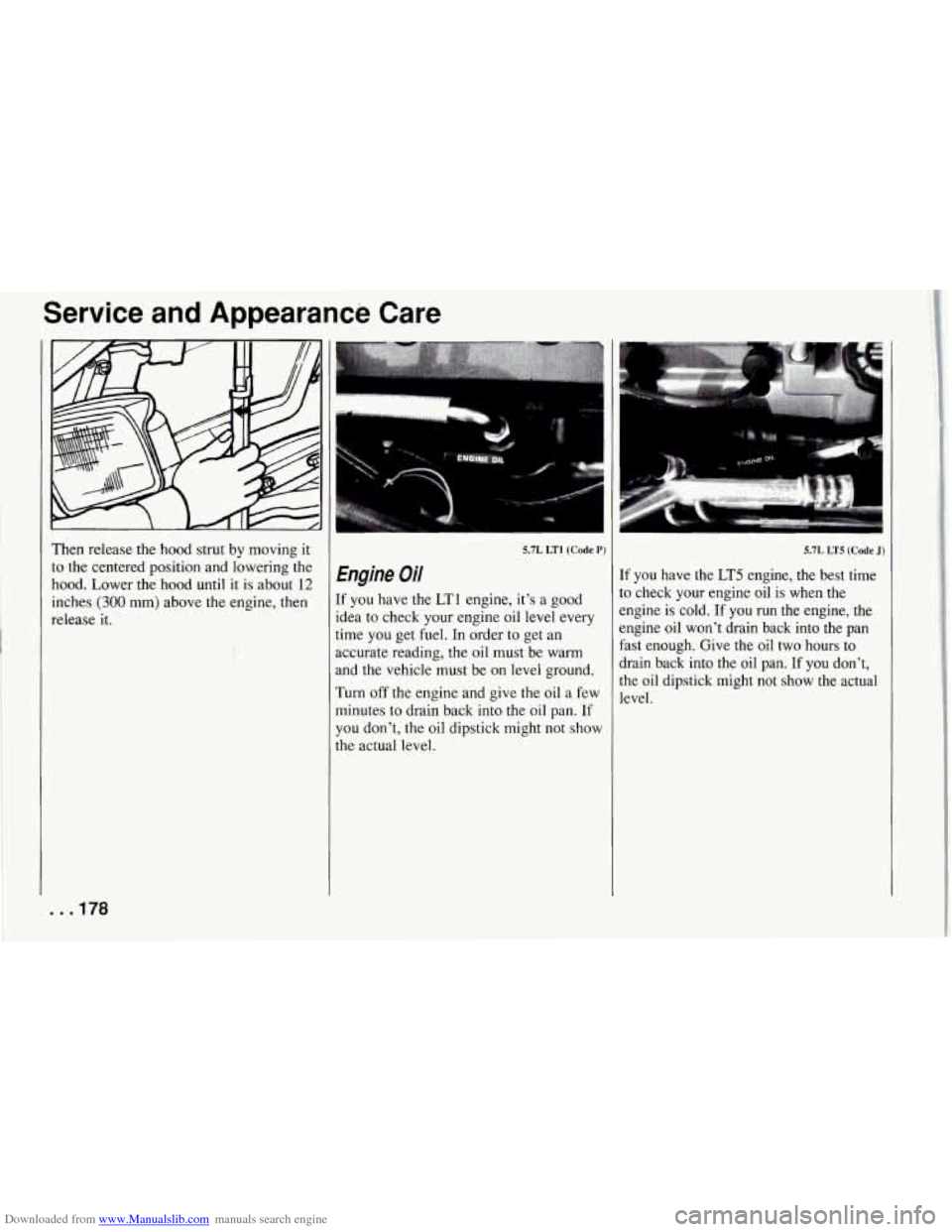
Downloaded from www.Manualslib.com manuals search engine Service and Appearance Care
Then release the hood strut by moving it
to the centered position and lowering the
hood. Lower the hood until it is about
12
inches (300 mm) above the engine, then
release it.
- - 178
I
!
5.7L LTl (Code P)
Engine Oil
If you have the LTl engine, it’s a good
idea to check your engine oil level every
time you get fuel. In order to get an
accurate reading, the oil must be warm
and the vehicle must be on level ground.
Turn off the engine and give the oil a few
minutes to drain back into the oil pan.
If
you don’t, the oil dipstick might not show
the actual level. d
tl
It
rain
le oi
:vel.
5.7L LT5 (Code J)
f you have the LT5 engine, the best time
3 check your engine oil is when the
ngine is cold. If you run the engine, the
ngine oil won’t drain back into the pan
ast enough. Give the oil two hours to
back into the oil pan. If you don’t,
1 dipstick might not show the actual
Page 180 of 274
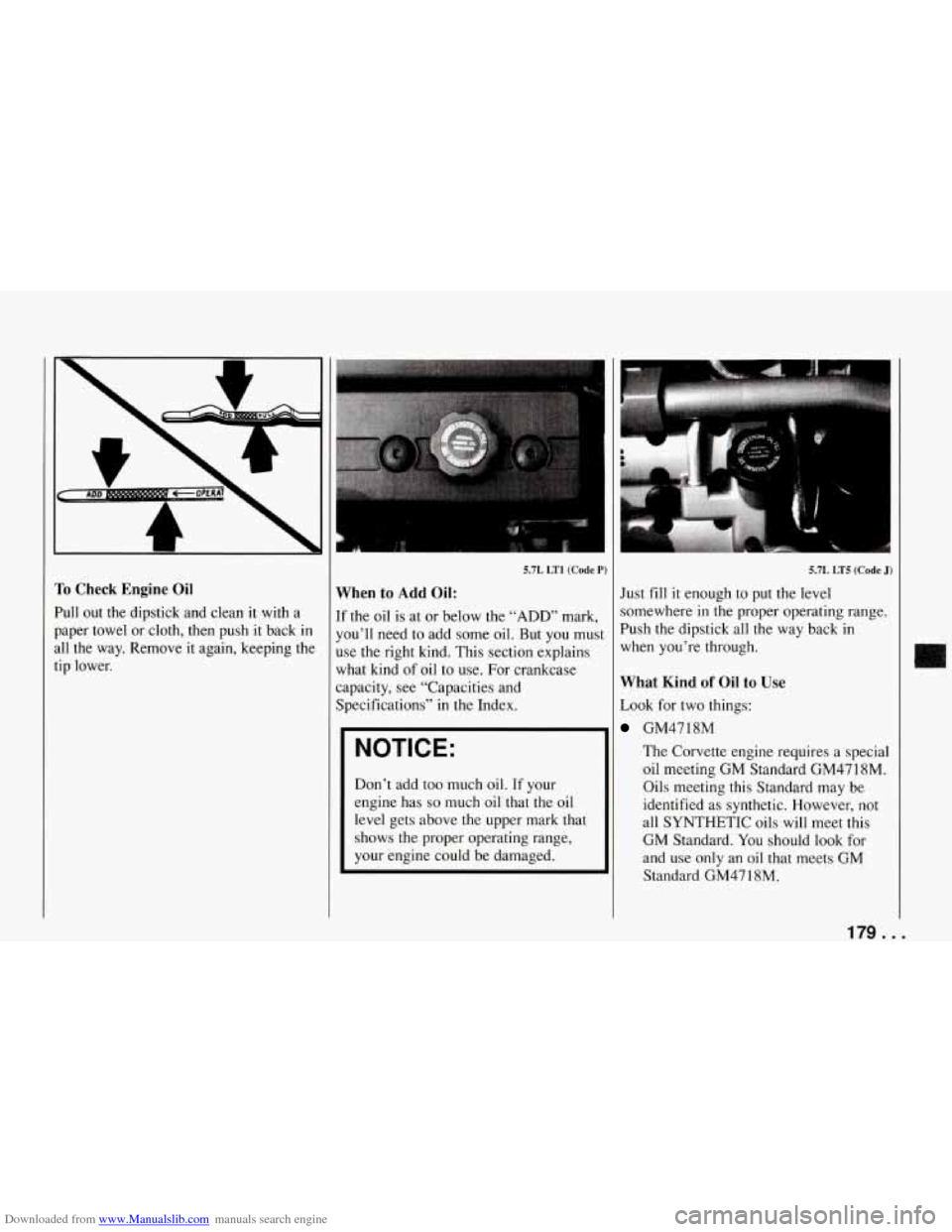
Downloaded from www.Manualslib.com manuals search engine - ..f’.’.*.‘.*.I.
To Check Engine Oil
Pull out the dipstick and clean it with a
paper towel or cloth, then push it back
in
all the way. Remove it again, keeping the
tip lower.
5.7L LTl (Code E
When to Add Oil:
If the oil is at or below the “ADD’ mark,
you’ll need to add some oil. But you musl
use the right kind. This section explains
what kind
of oil to use. For crankcase
capacity, see “Capacities and
Specifications” in the Index.
NOTICE:
Don’t add too much oil. If your
engine has
so much oil that the oil
level gets above the upper mark that
shows the proper operating range,
your engine could be damaged.
5.7L LT5 (Code J)
Just fill it enough to put the level
somewhere
in the proper operating range.
Push the dipstick all the way back
in
when you’re through.
What Kind of Oil to Use
Look for two things:
GM4718M
The Corvette engine requires a special
oil meeting GM Standard GM47 18M.
Oils meeting this Standard may be
identified as synthetic. However, not
all SYNTHETIC oils will meet this
GM Standard. You should look
for
and use only an oil that meets GM
Standard GM47 18M.
179 ...
Page 181 of 274
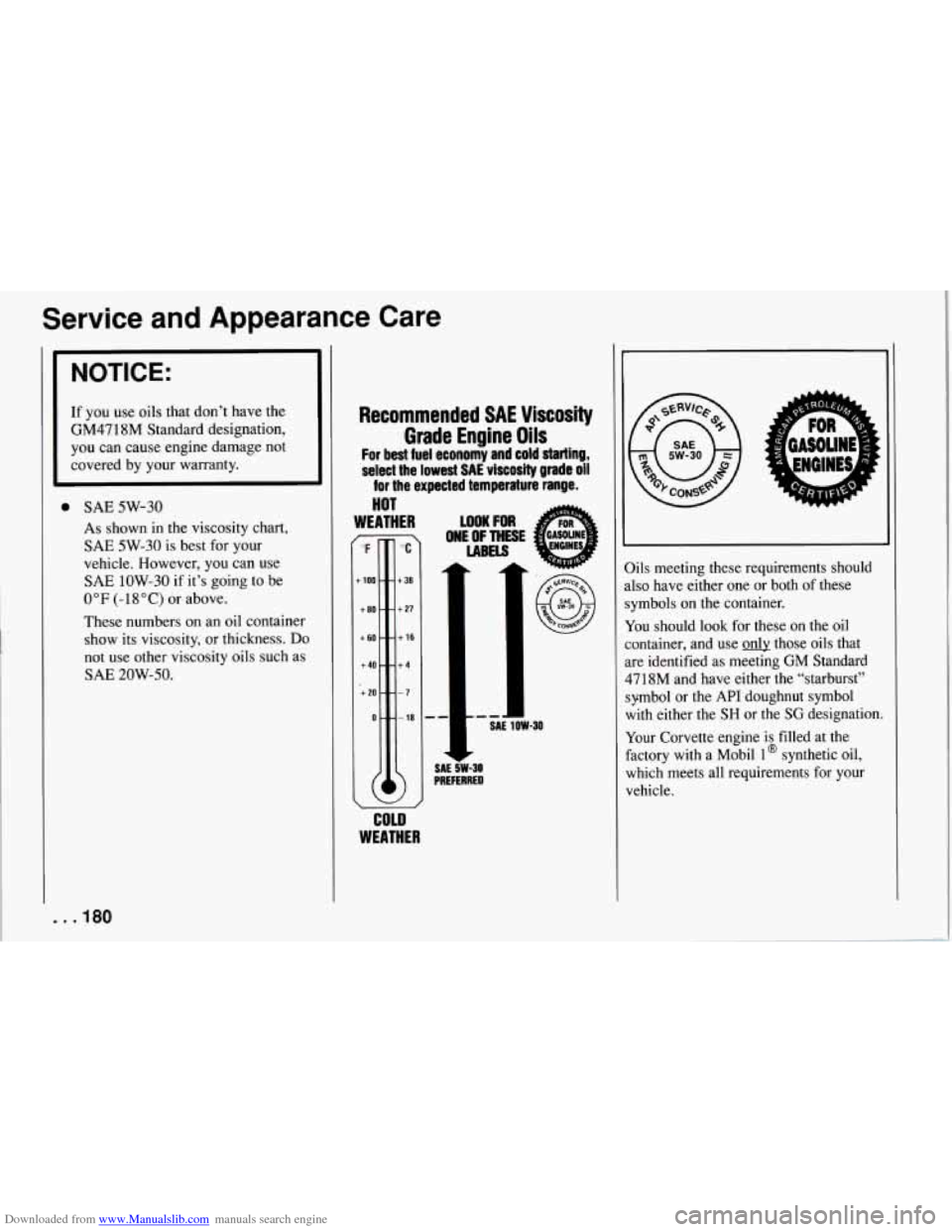
Downloaded from www.Manualslib.com manuals search engine Service and Appearance Care
I
NOTICE:
If you use oils that don’t have the
GM4718M Standard designation,
you can cause engine damage not
covered by your warranty.
0 SAE 5W-30
As shown in the viscosity chart,
SAE 5W-30 is best for your
vehicle. However, you can use
SAE 1OW-30 if it’s going to be
0°F (-18°C) or above.
These numbers
on an oil container
show its viscosity, or thickness.
Do
not use other viscosity oils such as
SAE 20W-50.
. .I80
Recommended SAE Viscosity
Grade Engine Oils
For best fuel economy and cold starting,
.select the lowest SAE viscosity grade oil
for the expected temperature range.
HOT
WEATHER
/
WEATHER
r
COLD
WOK FOR
LABELS
ONE OFTHESE @
1
-r
SAEZ-30
PREFERRED
Oils meeting these requirements should
also have either one or both of these
symbols
on the container.
You should look for these
on the oil
container, and use
o& those oils that
are identified as meeting GM Standard
4718M and have either the “starburst”
symbol or the
API doughnut symbol
with either the
SH or the SG designation.
Your Corvette engine is filled at the
factory with a Mobil
l@ synthetic oil,
which meets all requirements for your
vehicle.
Page 182 of 274

Downloaded from www.Manualslib.com manuals search engine Substitute Oil (LT1 Only): When adding
oil to maintain engine oil level, if an oil
meeting GM Standard GM4718M is not
available, you can use oil designated
either
SAE 5W-30 API Service SH or SG
at all temperatures, or
SAE 1OW-30 API
Service
SH or SG at temperatures above
0°F (-18°C). This oil should not be used
for an oil change.
Substitute Oil (LT5 Only): When adding
oil to maintain engine oil level, if an oil
meeting
GM Standard GM4718M is not
available, you can use oil designated SAE
1OW-30 API Service SH or
SG at all
temperatures. This oil should not be used
for an oil change.
Engine Oil Additives
Don’t add anything to your oil. Your
Chevrolet dealer is ready to advise if you
think something should be added.
When to Change Engine Oil
See if any one of these is true for you:
Most trips are less than 4 miles
It’s below freezing outside and most
trips are less than
10 miles (16 km).
(6 km).
The engine is at low speed most of
the time (as
in stop-and-go traffic).
Most trips are through dusty places.
If any one of these is true for your
vehicle, you need to change your oil and
filter every 3,000 miles
(5 000 km) or
3 months
- whichever comes first.
(See “Engine Oil Life Monitor” in the
Index.)
If none of them is true, change the oil
every 7,500 miles
( 12 500 km) or 12
months
- whichever comes first. Change
the filter at the first oil change and at
every other oil change after that. (See
“Engine Oil Life Monitor” in the Index.)
Engine Coolant Heater (Engine Block
Heater)
An engine coolant heater can be a big
help if you have to park outside in very
cold weather,
0 “F (- 18 “C) or colder. If
your vehicle has this feature, see “Engine
Coolant Heater” in the Index.
What to Do with Used Oil
Did you know that used engine oil
contains certain elements that may be
unhealthy for your skin and could even
cause cancer? Don’t let used oil stay on your
skin for very long. Clean your skin
and nails with soap and water, or a good
hand cleaner. Wash or throw away
clothing or rags containing used engine
oil. (See the manufacturer’s warnings
about the use and disposal of oil
products.)
Used oil can be a real threat to the
environment. If you change your own oil,
be sure to drain all free-flowing oil from
the filter before disposal. Don’t ever
dispose of oil by putting it in the trash,
pouring it on the ground, into sewers, or
into streams or bodies of water. Instead,
recycle
it by taking it to a place that
collects used oil. If you have a problem
properly disposing of your used oil, ask
your dealer, a service station or
a local
recycling center for help. L 1
181 ...
Page 185 of 274

Downloaded from www.Manualslib.com manuals search engine Service and Appearance Care
5.
0
0
Reverse the steps.
Align the tabs
to the slots in the
bottom of the assembly before you
replace it.
Install the short knob into the middle
hole first. Then install the longer
knobs into the outer holes.
Automatic Transmission Fluid
When to Check and Change
4 good time to check your automatic
:ransmission fluid level is when the
mgine oil is changed. Refer to the
Maintenance Schedule to determine when
co change your fluid. See “Scheduled
Maintenance Services” in the Index.
How to Check
Because this operation can be a little
iifficult, you may choose to have this
done at a Chevrolet dealership Service
Department.
[f you do it yourself, be sure to follow all
the instructions here, or you could get a
false reading on the dipstick.
NOTICE:
Too much or too little fluid can dam-
age your transmission.
Too much can
mean that some of the fluid could
come out and fall
on hot engine parts
or exhaust system, starting a fire. Be
sure to get an accurate reading if you
check your transmission fluid. Wait
at least 30 minutes before checking
the transmission fluid level if you have
been driving:
0 When outside temperatures are above
0 At high speed for quite a while.
0 In heavy traffic - especially in hot
To get the right reading, the fluid should
be at normal operating temperature, which is
180°F to 200°F (82°C to 93°C).
To check transmission fluid hot: Get
the vehicle warmed up by driving
about
15 miles (24 km) when outside
temperatures are above
50°F (10°C). If
it’s colder than
50°F (10°C)’ drive the
vehicle in
“D’ (Third Gear) until the
engine temperature gage moves and then
remains steady for ten minutes. Then follow the hot check procedures.
To check transmission fluid cold: A cold
check is made after the vehicle has been sitting for eight hours or more with the
engine
off and is used only as a reference.
Let the engine run at idle for five minutes
if outside temperatures are 50” F ( 1 OOC)
or more. If it’s colder than 50°F ( 10°C)’
you may have to idle the engine longer.
Should the fluid level be low during a
90°F (32°C).
weather.
. . .184
Page 189 of 274
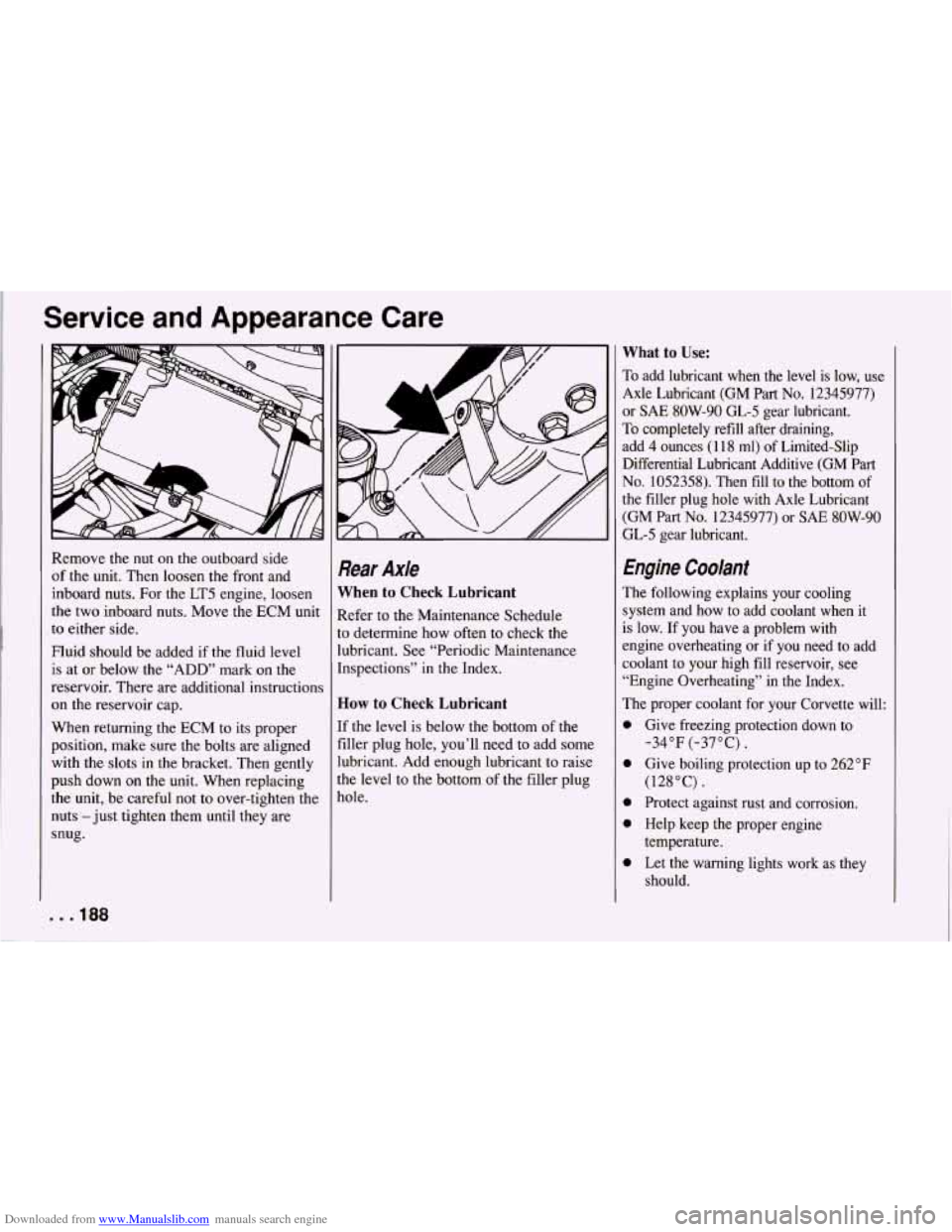
Downloaded from www.Manualslib.com manuals search engine Service and Appearance Care
Remove the nut on the outboard side
of the unit. Then loosen the front and
inboard nuts. For the LT5 engine, loosen
the two inboard nuts. Move the ECM unit
to either side.
Fluid should be added if the fluid level
is at or below the “ADD” mark on the
reservoir. There are additional instructions
on the reservoir cap.
When returning the ECM to its proper
position, make sure the bolts are aligned
with the slots in the bracket. Then gently
push down on the unit. When replacing
the unit, be careful not to over-tighten the
nuts -just tighten them until they are
snug.
. . * 188
Rear Axle
When to Check Lubricant
Refer to the Maintenance Schedule
to determine how often to check the
lubricant. See “Periodic Maintenance
Inspections” in the Index.
How to Check Lubricant
If the level is below the bottom of the
filler plug hole, you’ll need to add some
lubricant. Add enough lubricant to raise
the level to the bottom of the filler plug
hole.
What to Use:
To add lubricant when the level is low, use
Axle Lubricant (GM Part
No. 12345977)
or
SAE 8OW-90 GL-5 gear lubricant.
To completely refill after draining,
add 4 ounces (1 18 ml) of Limited-Slip
Differential Lubricant Additive (GM Part
No. 1052358). Then fill to the bottom of
the filler plug hole with Axle Lubricant
(GM Part
No. 12345977) or SAE 8OW-90
GL-5 gear lubricant.
Engine Coolant
The following explains your cooling
system and how to add coolant when
it
is low. If you have a problem with
engine overheating or
if you need to add
coolant to your high fill reservoir, see
“Engine Overheating” in the Index.
The proper coolant for your Corvette will:
0
0
0
0
0
Give freezing protection down to -34°F (-37°C).
Give boiling protection up to 262°F
(128°C).
Protect against rust and corrosion.
Help keep the proper engine
temperature.
Let the warning lights work as they
should.
Page 195 of 274

Downloaded from www.Manualslib.com manuals search engine Service and Appearance Care
NOTICE:
Don’t let someone put in the
wrong kind of fluid. For example,
just a few drops of mineral-based
oil, such as engine oil, in your
brake system can damage brake
system parts
so badly that they’ll
have to be replaced.
Brake fluid can damage paint,
so
be careful not to spill brake fluid
on your vehicle. If you
do, wash it
off immediately. See “Appearance
Care” in the Index.
Brake Wear
Your Corvette has four-wheel disc brakes.
Disc brake pads have built-in wear
indicators that make a high-pitched
warning sound when the brake pads are
worn and new pads are needed. The
sound may come and go or be heard all
the time your vehicle is moving (except
when you are pushing
on the brake pedal
firmly).
I NOTICE:
I
Continuing to drive with worn-out
brake pads could result in costly brake repair.
Some driving conditions or climates may
cause a brake squeal when the brakes are
first applied or lightly applied. This does not mean something is wrong with your
brakes. Brake linings should always be
replaced as complete axle sets.
Brake Pedal Travel
See your dealer if the brake pedal does
not return to normal height, or if there is
a rapid increase in pedal travel. This
could be a sign of brake trouble.
Brake Adjustment
As you make brake stops, your disc
brakes automatically adjust for wear.
Replacing Brake System Parts
The braking system on a modern vehicle
is complex. Its many parts have to be of
top quality and work well together
if the
vehicle is to have really good braking.
Vehicles we design and test have
top-quality GM brake parts in them, as
your Corvette does when it is new. When
you replace parts of your braking system
- for example, when your brake linings
wear down and you have to have new
ones put in
- be sure you get new
genuine GM replacement parts. If you
don’t, your brakes may no longer work
properly. For example,
if someone puts
in brake linings that are wrong for your
vehicle, the balance between your front
and rear brakes can change, for the worse. The braking performance you’ve come to
expect can change in many other ways
if
someone puts in the wrong replacement
brake parts.
. . .I94